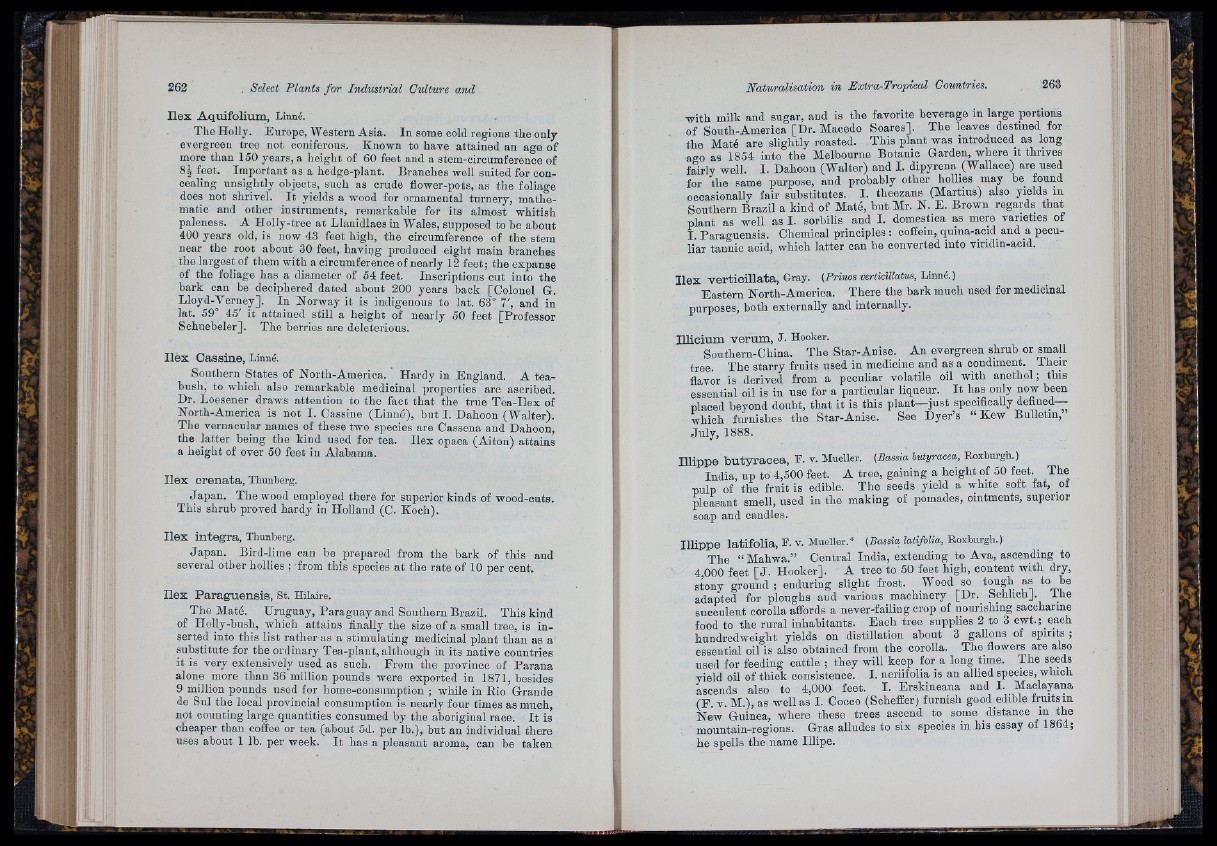
262 Select Plants fo r Industrial Culture and
Ilex Aquifolium, Linné.
The Holly. Europe, Western Asia. In some cold regions the only
evergreen tree not coniferous. Known to have attained an age of
more than 150 years, a height of 60 feet and a stem-cironmference of
8^ feet. Important as a hedge-plant. Branches well suited for concealing
unsightly objects, such as crude flower-pots, as the foliage
does not shrivel. I t yields a wood for ornamental turnery, mathe-
matic and other instruments, remarkable for its almost whitish
paleness. A Holly-tree a t Llanidlaes in Wales, supposed to be about
400 years old, is now 43 feet high, the circumference of the stem
near the root about 30 feet, having produced eight main branches
the largest of them with a circumference of nearly 12 feet; the expanse
of the foliage has a diameter of 54 feet. Inscriptions cut into the
bark can be deciphered dated about 200 years back [Colonel G.
Lloyd-Verney]. In Norway it is indigenous to lat. 63° 7', aud in
lat. 59° 45' it attained still a height of nearly 50 feet [Professor
Schuebeler]. The berries are deleterious.
Ilex Cassine, Linné.
Southern States of North-America. ' Hardy in England. A tea-
bush, to which also remarkable medicinal properties are ascribed.
Dr. Loesener draws attention to the fact th a t the true Tea-Hex of
North-America is not I . Cassine (Linné), but I. Dahoon (Walter).
The vernacular names of these two species are Cassena and Dahoon,
the latter being the kind used for tea. Ilex opaca (Aiton) attains
a height of over 50 feet in Alabama.
Ilex crenata, Thnnberg.
Japan. The wood employed there for superior kinds of wood-cuts.
This shrub proved hardy in Holland (C. Koch).
Ilex integra, Thunberg.
Japan. Bird-lime can be prepared from the bark of this and
several other hollies ; from this species a t the rate o f 10 per cent.
Ilex Paraguensis, St. Hilaire.
The Maté. Uruguay, Paraguay and Southern Brazil. This kind
of Holly-bush, which attains finally the size of a small tree, is inserted
into this list rather as a stimulating medicinal plant than as a
substitute for the ordinary Tea-plant, although in its native countries
it is very extensively used as such. From the province of Parana
alone more than 36 million pounds were exported in 1871, besides
9 million pounds used for home-consumption ; while in Rio Grande
de Sul the local provincial consumption is nearly four times as much,
not counting large quantities consumed by the aboriginal race. I t is
cheaper than coffee or tea (about 5d. per lb.), but an individual there
uses about 1 lb. per week. I t has a pleasant aroma, can be taken
with milk and sugar, and is the favorite beverage in large portions
of South-America [Dr. Macedo Soares], The leaves destined for
the Maté are slightly roasted. This plant was introduced as long
ago as 1854 into the Melbourne Botanic Garden, where it thrives
fmrly well. I. Dahoon (Waiter) and I. dipyrena (Wallace) are used
for the same purpose, and probably other hollies may be found
occasionally fair substitutes. I . theezans (Martius) also yields in
Southern Brazil a kind of Maté, but Mr. N. E. Brown regards th a t
plant as well as I. sorhilis and I. domestica as mere varieties of
I. Paraguensis. Chemical principles : coffein, quina-acid and a peculiar
tannio acid, which latter can be converted into viridin-aoid.
Ile x verticillata. Gray. (PrinosvertkUUtus.Lmné.)
Eastern North-America. There the bark much used for medicinal
purposes, both externally and internally.
Illicium verum, J- Hooker.
Southern-China. The Star-Anise. An evergreen shrub or small
tree. The starry fruits used in medicine and as a condiment. Their
flavor is derived from a peculiar volatile oil with anethol; this
essential oil is in use for a particular liqueur. I t has only now been
placed beyond doubt, th a t it is this plant—ju s t specifically defined—
which furnishes the Star-Anise. See Dyer’s “ Kew Bulletin,”
Ju ly , 1888.
Illippe butyracea, F. V. Mueller. (Bassia hutyracea, Roxburgh.)
India, up to 4,500 feet. A tree, gaining a height of 50 feet. The
pulp of the fruit is edible. The seeds yield a white soft fat, of
p e a s a n t smell, nsed in the making of pomades, ointments, superior
soap and candles.
Illippe latifolia, F. v. Mueller.* (Bassia latifolia, Roxburgh.)
The “ Mahwa.” Central India, extending to Ava, ascending to
4,000 feet [ J . Hooker]. A tree to 50 feet high, content with dry,
stony ground ; enduring slight frost. Wood so tough as to be
adapted for ploughs and various machinery [Dr. bchlichj. Ih e
succulent corolla affords a never-failing crop of nourishing saccharine
food to the rural inhabitants. Each tree supplies 2 to 3 cwt.; each
hundredweight yields on distillation about 3 gallons of spirits ;
essential oil is also obtained from the corolla. The flowers are also
used for feeding cattle ; they will keep for a long time. The seeds
yield oil of thick consistence. I. neriifolia is an allied species, which
ascends also to 4,000- feet. I . Erskineana and I. Maclayana
(F . V. M.), as well as I. Coceo (Scheffer) furnish good edible fruits in
New Guinea, where these trees ascend to some distance in the
mountain-regions. Gras alludes to six species in his essay of 1864;
he spells the name Illipe.